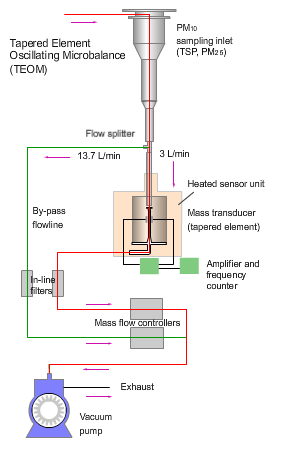Tapered element oscillating microbalance
Tapered element oscillating microbalance (TEOM) is a technique used to continuously measure concentrations of air particles.
It consists of an instrument fitted with a size-selective inlet to sample one of the following particle size ranges:
- total suspended particulate (TSP)
- particles less than 10 micrometres in diameter (PM10)
- particles less than 2.5 micrometres in diameter (PM2.5)
How it works
The animation below shows how the TEOM instrument operates.

A tapered element oscillating microbalance analyser
A pump draws a sample into the instrument at 16.7 litres per minute (L/min) through an inlet designed to allow only particles of the required size range to pass through.
This air stream is then split so that 3L/min of sample is directed to the tapered element while the remainder is sent to exhaust.
The tapered element consists of a filter cartridge mounted on the tip of a hollow glass tube. The base of the tube cannot move, but the tip is free to vibrate at its natural frequency (in a similar way to a tuning fork).
Any additional weight from particles that collect on the filter changes the frequency at which the tube oscillates. The electronic circuitry senses this change and calculates the particle mass rate from the magnitude of the frequency change.
The instrument then returns the vibrating glass tube to its natural frequency ready for the next measurement.
The instrument maintains a constant temperature and flow rate, and electronically smooths the readings to reduce noise.
Dividing the mass rate by the flow rate provides a continuous output of the particle mass concentration.
The advantages of continuous monitoring of particles
TEOM samplers operate continuously and do not need filter changes as frequently as high-volume air samplers do.
This means the analysers can provide additional information, such as the time of day that peak particle concentrations occur.
Used in conjunction with meteorological data, this helps identify sources of particle emissions.
More information
View the live air data service to check the current levels of air particles in the monitoring network.


